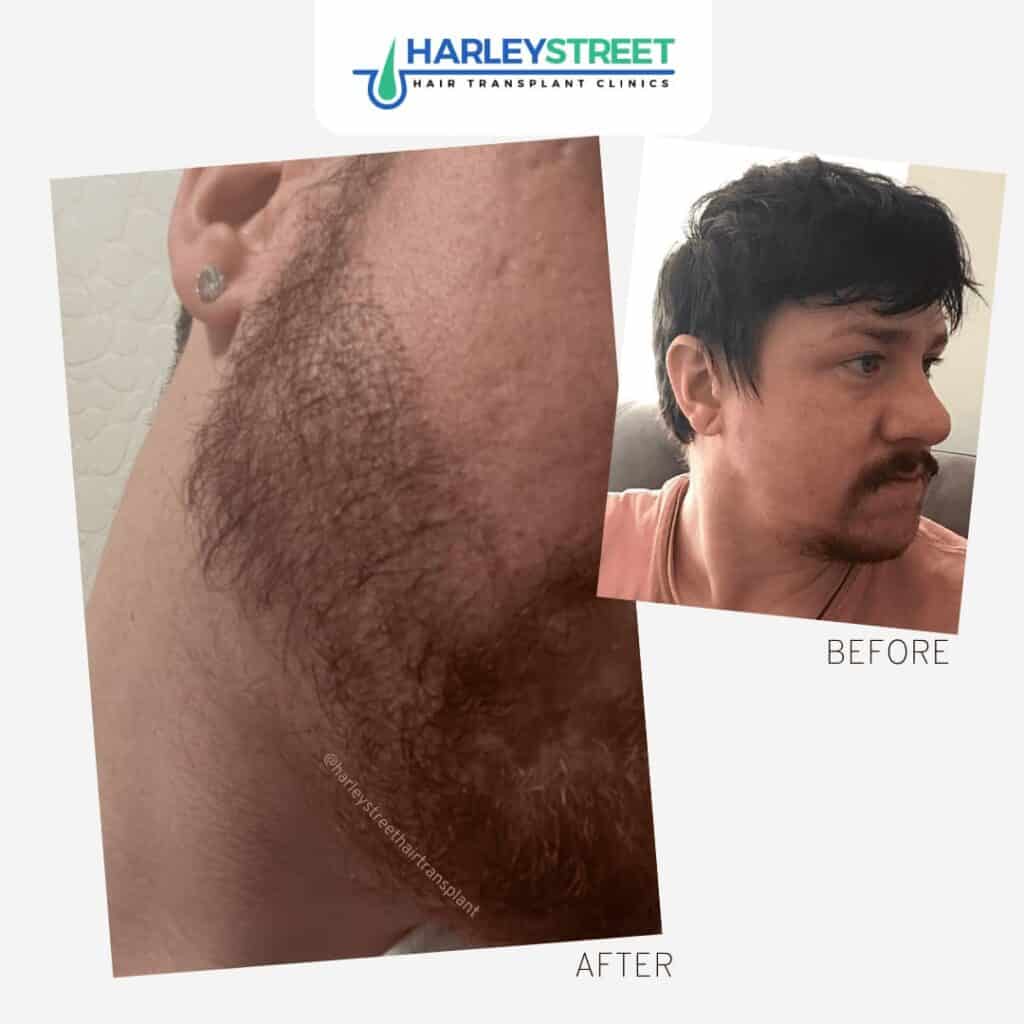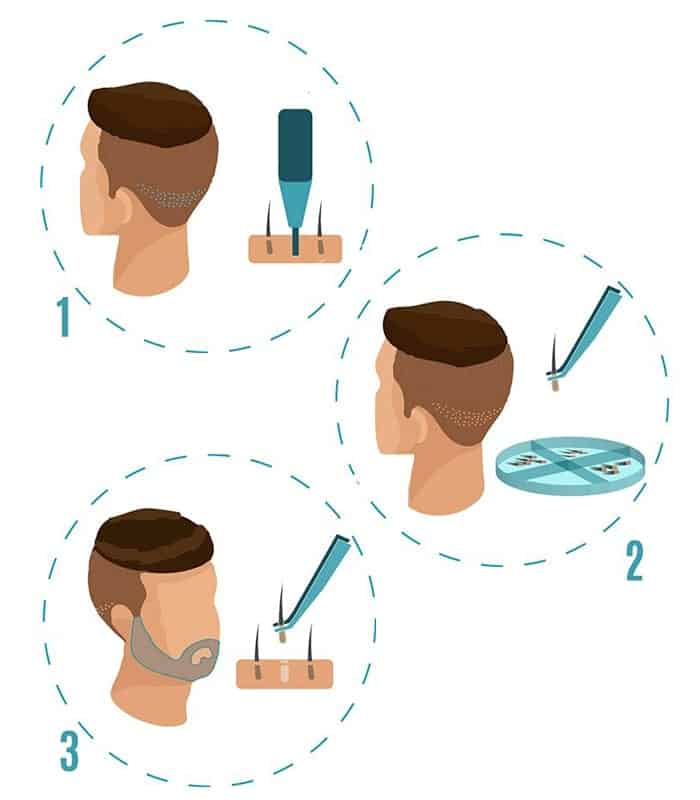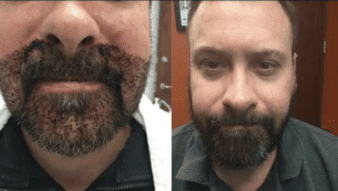Method Used: FUE (Follicular Unit Extraction)
Cost: £3,000 – £7,000
Beard Transplant

Beard (Facial Hair) Transplant London
At Harley Street Hair Transplant Clinics, we are well aware of the pressures facing men to look good all the time! With a healthy beard being considered as a sign of good health and looks, many men come to us looking for a beard transplant.
A beard transplant, or facial hair transplant, in essence transplants (or “transports”) healthy hair follicles by implanting them from the patient donor area (which is typically the back of the patient’s scalp) onto the areas of hair loss of the beard area. All of our beard transplants are carried out by certified hair transplant surgeons. Hair loss, or having sparse facial hair, is a common problem for adult men of all ages.
If you’re concerned about facial hair loss, here’s some helpful information to help you regain your confidence.
What is a Beard Transplant?
Put simply, a beard transplant is a facial hair restoration procedure that works by transplanting your own hair (from other areas of your body namely the back of your scalp), and implanting them into the affected area. A beard transplant is a clinically proven method to treat hair loss in your beard and moustache areas of your face.
How Does a Beard Transplant Work?
After booking your free consultation with one of our hair transplant surgeons, you will both decide on the beard transplant procedure that is not only going to maximise your end results, but work around your busy schedule.
On the day of your beard transplant, the FUE procedure requires the need for local anaesthetic. This will ensure you won’t feel a thing and can fully relax during the procedure.
Following this, the new beard design will be performed and is then followed by hair extraction from your donor area. The donor area is the area at the back and sides of the head as these follicles are not affected by the hair loss hormone dihydrotestosterone (DHT) and thus are the perfect ones to use. They will then be implanted into the affected area.
Fast forward a few months in order for your new beard hair to grow, you will notice that your new beard will have a natural appearance, looking much fuller than before. What is even more impressive is that your transplant will continually promote beard growth long into the future. It really is a long-term solution!

Results and Beard transplant Aftercare
The results of FUE surgery are certainly to be desired! When compared to alternative treatments, no other procedure or remedy quite compares. FUE not only ensures that you will leave our clinic with results that are almost noticeable immediately, but that you will be able to grow a fuller beard for years to come.
With FUE surgery, you can typically expect all scarring to have healed within 6-7 days. Moreover, as there are no need for stitches (as there is with FUT surgery), no patient has complained of scalp tightness or major pain after the surgery.
If, however, you have any problem after your surgery, our clinic prides itself on offering industry leading aftercare. Don’t hesitate to get in touch with us at:

Why Should I get a Beard Transplant?
There are many reasons as to why patients come to us wishing for a beard transplant. Whether it be for a medical purpose, a decision to cover up visible scarring, or a need to restore some much needed self confidence, we have you covered! Anyway, on with the explanations…
Alopecia Barbae, defined as hair loss in the beard area, is a common problem facing men of all ages. Characterised by symptoms such as hair shedding, redness on the face and neck, the appearance of bald spots on the face, there are a range of explanations for the condition:
- Facial Trauma – the experience of physical trauma, from events such as car crashes or chemical burns, are a common explanation for facial baldness. Many patients who have experienced this want a beard transplant to hide any signs of visible scarring.
- Medical Treatments – Often, cancer treatments such as chemotherapy and radiotherapy have many negative side effects. One of which is the experience of hair loss all over the body. Unfortunately, beard hair is no less susceptible.
- Alopecia Barbae – This autoimmune disease, sometimes labelled as the ‘smaller brother’ of alopecia areata, is where the body’s immune system attacks (and shrinks) hair follicles in the facial area.
- Trichotillomania – this is the name given to a psychological condition in which patients (often unknowingly) cause facial hair loss through constant touching, pulling, and straining of the beard.
According to YouGov, it is currently estimated that 55% of men across the world have beards. What’s more is that this number is seen to be continually rising across the world. Even in Britain, the percentage of men with beards has increased from 37% in 2011 to 42% in 2016. As a result, those unable to grow fuller beards look for solutions to fit in with this rising trend.
FAQs
A beard transplant can cost anywhere between £3,500 and £6,000. This variance in price is predominantly down to the severity of each patient’s baldness. With FUE and FUT transplants, patients pay based on the number of grafts that are transplanted.
- FUT: Between £2 and £5 per graft used.
- FUE: Between £1.89 and £3.99 per graft used.
Whilst beard transplants and hair transplants are carried out using the same techniques, the main difference between the two is where donor areas can be found. In the case of hair transplants, donor hairs are often taken from the back and sides of the head, behind the ears. Typically, donor hairs for a beard transplant are almost exclusively taken from the back of the scalp. This is down to the length and colour of the follicles being a great match for your existing beard hairs.
As with any surgery, if any part of the skin is broken, it can leave a little or faint scar that will heal if you give it time. Despite this, with FUE surgery our surgeons use instruments that are less than 1mm un diameter. his means that any initial scarring is unlikely to be seen in the moustache, sideburn, or beard area.
After the procedure, our advice is to avoid shaving for around 2 weeks. This is because your skin may be swollen or tender in the immediate aftermath of your treatment.
As a beard transplant is performed whilst you are given local anaesthetic, it is a relatively pain free procedure. Post surgery, you may experience slight inflammation and redness in the donor and recipient areas.
Patient Testimonials
Aside from achieving fantastic results, we believe that keeping in touch with our patients before, during and after their hair transplantation procedure is paramount – it helps to keep our patients feeling calm and in control. We’re always on hand to provide guidance, support and aftercare advice. Time and again, our patients tell us that this is what sets us apart from other clinics.
You can read our great reviews of FUE hair transplants over on Google and TrustPilot





